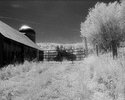removedacct2
Member
- Joined
- May 26, 2018
- Messages
- 366
I wanted to see if Tanol makes a difference on Foma films. Wolfgang Mörsch provides no data for these films, so I extrapolated some possible times, and tried Fomapan-100 with 16 mn @20C, regular agitation (30s then 2 inversions every minute) and it gave results similars to Fomadon Excel.
But in order to compare I am now shooting in double, one negative processed in Excel for 6mn, the other in Tanol 16mn. These are 4x5, scanned at 2400dpi on Epson V700, inverted with ColorPerfect, Fomadon Excel on the left, Tanol on the right:


comparison is of course also complicated by the fact that optimal time in Excel is not easy to set, 5 or 6 mn...
a 200% Excel/Tanol detail of the 1st image:

a 50% part of the 2nd image:

then for Retropan-320 I shot in triple, one picture for reference in Retrodev, another in Tanol 15mn, another in Tanol for 18mn, need to bracket in order to find out, yet 15mn or 18mn didn't make much difference...
Retrodev vs Tanol 15mn:

Retrodev and Tanol for 18mn. Retrodev was freshly mixed and times given by Foma are 4-5 mn, I went to 5mn and maybe it was a little bit longer than optimal... Very sunny late evening, snow smelted couple days ago so the grass there is brownish/yellowish.

in fact I am not sure which one was 15mn in Tanol, which 18mn: I developed both in the same tank, took out in the dark one after 15mn and dumped it in a stop bath, while the remaining in the tank was left until 18mn. After the stop bath I dumped the negatives each in a different tray for fixing, and that's when I am not sure I mixed the labels taped on the side of the trays...
so side by side, one was 15mn in Tanol, the other 18mn and I'd say the 18mn is on the right...

100% of the crane area, Excel vs Tanol-18mn:

Fomapan-100 and Retropan-320 are stained brownish, Tanol on the left:

well hard to tell how much, if possible can be gained in this case, with Tanol, but at least I have some reference for playing further. Foma in 4x5 is cheap, so can afford to waste some film.
But in order to compare I am now shooting in double, one negative processed in Excel for 6mn, the other in Tanol 16mn. These are 4x5, scanned at 2400dpi on Epson V700, inverted with ColorPerfect, Fomadon Excel on the left, Tanol on the right:
comparison is of course also complicated by the fact that optimal time in Excel is not easy to set, 5 or 6 mn...
a 200% Excel/Tanol detail of the 1st image:
a 50% part of the 2nd image:
then for Retropan-320 I shot in triple, one picture for reference in Retrodev, another in Tanol 15mn, another in Tanol for 18mn, need to bracket in order to find out, yet 15mn or 18mn didn't make much difference...
Retrodev vs Tanol 15mn:
Retrodev and Tanol for 18mn. Retrodev was freshly mixed and times given by Foma are 4-5 mn, I went to 5mn and maybe it was a little bit longer than optimal... Very sunny late evening, snow smelted couple days ago so the grass there is brownish/yellowish.
in fact I am not sure which one was 15mn in Tanol, which 18mn: I developed both in the same tank, took out in the dark one after 15mn and dumped it in a stop bath, while the remaining in the tank was left until 18mn. After the stop bath I dumped the negatives each in a different tray for fixing, and that's when I am not sure I mixed the labels taped on the side of the trays...
so side by side, one was 15mn in Tanol, the other 18mn and I'd say the 18mn is on the right...
100% of the crane area, Excel vs Tanol-18mn:
Fomapan-100 and Retropan-320 are stained brownish, Tanol on the left:
well hard to tell how much, if possible can be gained in this case, with Tanol, but at least I have some reference for playing further. Foma in 4x5 is cheap, so can afford to waste some film.






